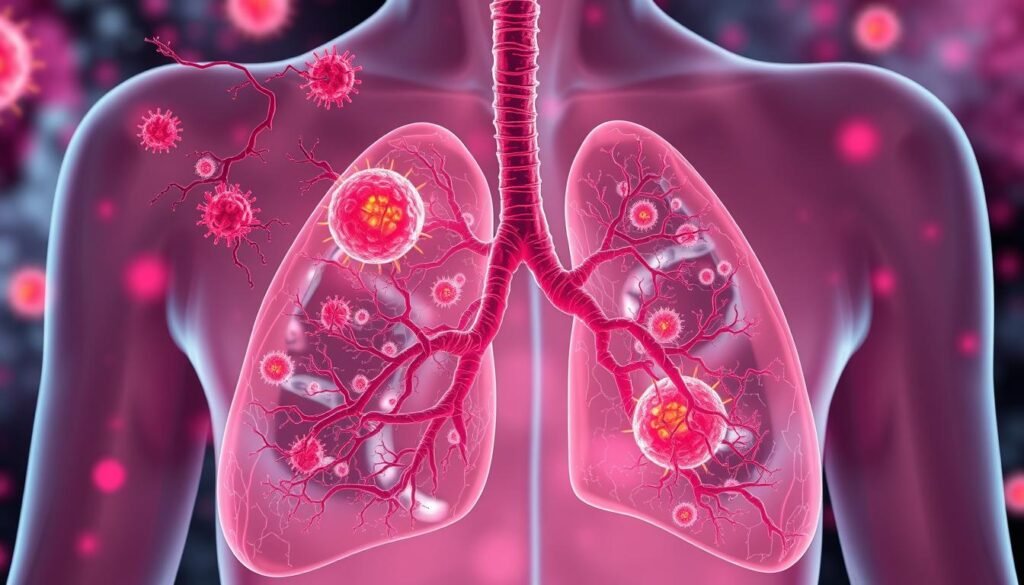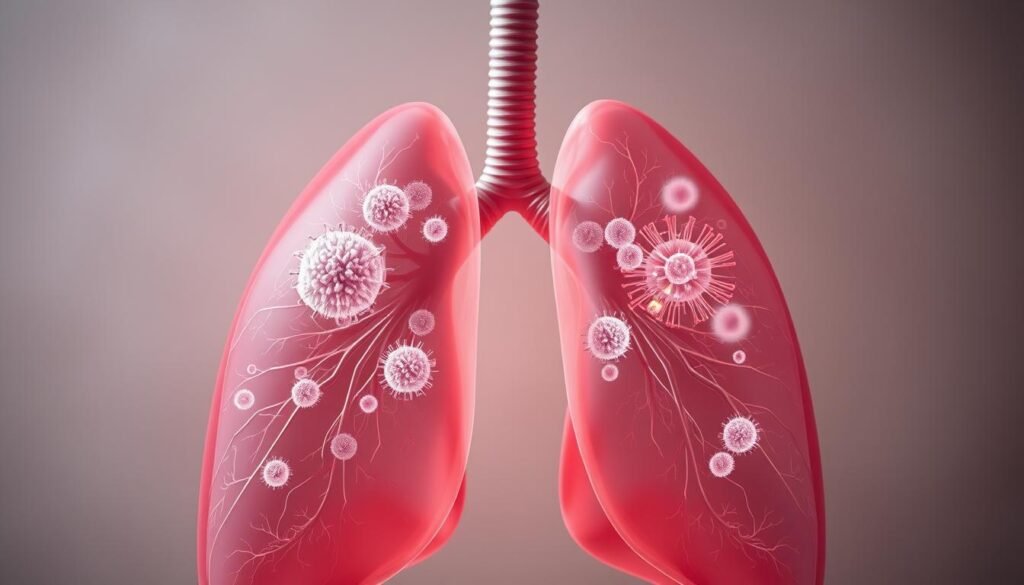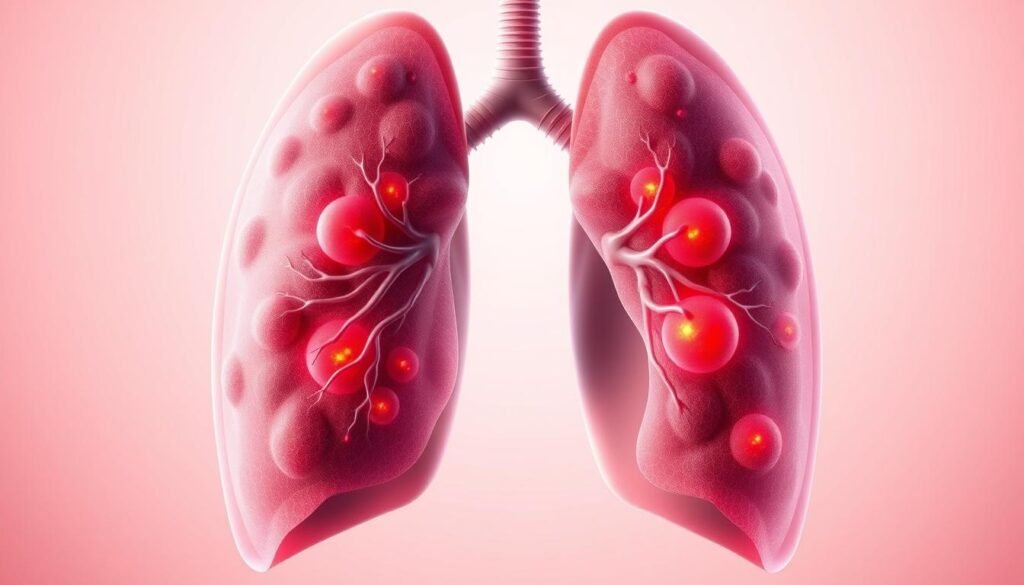Did you know around 60% of Stage 4 breast cancer patients might get lung metastasis? This fact shows how important it is to know about breast cancer spreading to the lungs. Breast cancer is the top cancer diagnosis in the U.S. In 2024, we expect 310,720 new cases.
The average survival time after breast cancer spreads to the lungs is about 21 months. This statistic shows the big effect on survival rates and life quality. Knowing more about this helps people make better choices about their treatment and health management.
Key Takeaways
- Understanding breast cancer metastasis to lungs is crucial for prognosis and treatment options.
- The survival rate for breast cancer that has spread to the lungs is about 10.94% over five years.
- Survival rates vary significantly based on patient demographics and breast cancer subtypes.
- Systemic treatments and local surgeries show similar overall survival rates after three years.
- Approximately 30% of women with early-stage breast cancer may develop metastatic breast cancer later.
- Bone metastasis is more common than lung metastasis in Stage 4 breast cancer patients.
- A clear understanding of treatment impacts can lead to improved patient outcomes.
Introduction to Breast Cancer Metastasis
Breast cancer spread, or metastasis, is a major step in the disease’s growth. It happens when cancer moves from the breast to other body parts, especially the lungs. This is a big problem because lung spread is common in people with advanced breast cancer. About 36.4% of breast cancer patients end up with cancer in their lungs. It shows why it’s crucial to watch for and find cancer spread early.
When cancer spreads to the lungs, treating it becomes harder, and it worsens the outlook for patients. Research shows that 10.5% of patients with breast cancer in their lungs have it only there. These patients have an average life span of 21 months after diagnosis. Sadly, only about 15.5% of them live longer than three years. This shows the urgent need for treatments that meet each patient’s specific needs.
Some breast cancers are more likely to spread to the lungs than others. For example, 45.3% of lung spread cases involve a specific cancer type called HR−/HER2−. Things like age, race, and how severe the tumor is can affect how long someone lives with metastatic breast cancer. Often, this type of cancer is more common in older women and black patients. This points to certain groups being more at risk.
Understanding how breast cancer moves to the lungs is crucial. It can help doctors improve how they treat people with this kind of advanced cancer. Better treatments could change the future for people living with metastatic breast cancer.
Understanding Metastasis: How Breast Cancer Spreads
Metastasis is when cancer spreads from its original spot to other body parts. For those with breast cancer, it’s tough when the cancer moves to the lungs. Knowing how metastasis mechanisms work helps doctors better treat and help patients with late-stage cancer.

Cancer cells from the breast can break away and spread to nearby areas. They might get into the blood or lymphatic systems. As they move, these cancer cell migration steps are complex, involving lymph nodes or blood vessels. They can then travel to and settle in far-off organs, like the lungs.
About 60% of folks with cancer that has spread will have it reach their lungs. This stage IV cancer has gone beyond the breast and nearby lymph nodes. It keeps the name of the original cancer, so we call it metastatic breast cancer when it’s in the lungs.
Some people might not know they have this cancer because it can stay hidden for a long time. Finding it early helps make lung cancer treatment more successful. Scientists are learning a lot that helps treat those with lung metastases. The big challenge is managing symptoms and trying to help people live longer.
Incidence of Lung Metastases in Breast Cancer Patients
Lung metastases are a significant worry for breast cancer patients. About 36.4% of stage IV patients see their cancer spread to the lungs. This fact is vital in understanding breast cancer statistics and the need for careful follow-up.
Certain tumor subtypes, like HR−/HER2+ and triple-negative, are more likely to spread to the lungs. This makes it crucial to know a patient’s specific cancer type. It greatly affects treatment choices and the chance of recovery.
A study examined 253 women with lung metastases. The average age was 56 years. They were followed for an average of 5.4 years, shedding light on survival rates.
Patients who had all lung metastases removed did better. They had a 5-year survival rate of 38%, which is higher than others. This shows the benefit of complete resection for some.
These results are very important. They help doctors and patients understand the risks with different breast cancer types. Plus, they underline the need for careful monitoring.

Symptoms of Breast Cancer Metastasis to the Lungs
When breast cancer spreads to the lungs, it can cause specific symptoms. These symptoms can look like other lung problems. This makes it hard to find out early. The main signs to watch out for include:
- A persistent cough that may get worse and be very bothersome.
- Difficulty breathing, especially during normal daily activities.
- Chest pain, which can change in how bad it feels and how often it happens.
- Coughing up blood, a serious symptom that means you need to see a doctor fast.
- Pleural effusion, which is when fluid builds up around the lungs, causing more discomfort and trouble breathing.
People might also lose weight without trying and not feel like eating. This can make their overall health worse. It’s very important to recognize these signs of advanced lung cancer. Doing so helps start treatment early. Early treatment can really help improve life for those with lung metastasis from breast cancer.

Breast Cancer Metastasis to Lung Prognosis: Key Factors
The outlook for lung metastasis from breast cancer depends on patient and tumor details. These factors are key in deciding how long patients will live. Knowing these aspects helps tailor treatment plans and care strategies.
Patient Demographics and Outcomes
Age greatly impacts survival chances in metastatic breast cancer cases. Before 50 years, only 5.0% are diagnosed. Between 50 to 69 years, 63.7% are found, and over 70, 31.2%. The median diagnosis age is 62, and they’re followed for about 10 months.
Younger patients often live longer, with a median survival of 32 months. Middle-aged patients have a survival of 25 months and older ones 16 months. These numbers show how age changes survival rates.
Tumor Subtypes and Their Impact on Survival
Tumor types also affect how long patients live. Older patients with one site of metastasis, like the lung, have rates of 14.2%. Younger and middle-aged patients have lower rates, 5.9% and 7.6%, respectively. Patients with only bone metastasis live longer than those with metastases in multiple locations. For more on breast cancer lung metastases, see this study.
Treatment Options for Lung Metastasis from Breast Cancer
Treatment strategies for lung metastasis from breast cancer often focus on reducing tumor size. They combine chemotherapy, targeted therapy, and immunotherapy. These address the unique aspects of the disease.
Systemic Treatments: Chemotherapy and Targeted Therapy
Chemotherapy is key in treating lung cancer, focusing on cancer cells that grow quickly. It can offer quick benefits, but recovery times vary. Targeted therapy is a big leap forward. It zeroes in on cancer cell mutations. This offers a tailored approach, possibly with less side effects.
Role of Immunotherapy in Advanced Lung Cancer
Immunotherapy uses the body’s immune system to fight cancer cells. It’s promising for advanced stages and can work well with other treatments. Each treatment plan is unique, but combining therapies can improve patient outcomes.
Knowing all treatment options helps patients and caregivers in their battle. It’s important to talk with doctors about the best treatments for their situation.
| Treatment Type | Description | Benefits | Considerations |
|---|---|---|---|
| Chemotherapy | Targets rapidly dividing cancer cells | Widely used, immediate effects | Possible side effects include fatigue and nausea |
| Targeted Therapy | Focuses on specific molecular changes | Personalized approach, potentially fewer side effects | Requires biomarker testing |
| Immunotherapy | Enhances the immune response against cancer | Promising for advanced cases, less toxicity | Not suitable for all patients |
Learning about treatments and their details, including lung cancer treatment options, is key to making informed care decisions.
Palliative Care Strategies for Lung Cancer Patients
Palliative care is vital for lung cancer patients. It aims to make life better for those with advanced cancer. The focus is on comprehensive symptom management. It tackles the physical and emotional problems that come with cancer spreading. Key strategies include:
- Pain management: Custom pain relief methods reduce discomfort.
- Nutritional support: Better diets boost strength and health.
- Psychosocial interventions: Emotional support is key for well-being.
Oncologists and palliative care experts work together in this approach. Their teamwork improves patient results. It makes sure cancer-fighting and comfort care blend seamlessly during treatment. Assessing symptoms early is crucial. It builds trust, enhances communication, and addresses patient worries.
A lot of lung cancer patients, 55% to 87%, struggle with shortness of breath. Actively managing symptoms is essential. Exercise programs can make breathing easier and help patients feel more in control.
For those with low oxygen levels, extra oxygen therapy is often suggested. It helps maintain oxygen levels during rest, sleep, or activity.
| Strategy | Description |
|---|---|
| Pain Management | Customizing pain relief approaches to individual patient needs. |
| Nutritional Support | Enhancing diet to improve overall patient health and resilience. |
| Psychosocial Support | Offering emotional resources to help cope with cancer-related stress. |
| Exercise Training | Incorporating physical activity to improve lung function and quality of life. |
| Supplemental Oxygen Therapy | Providing oxygen support for patients with low oxygen levels. |
Using these strategies can make a big difference in patient comfort and life quality. They offer crucial support during hard times.
Survival Rates and Prognostic Outcomes
Learning about the survival rates for breast cancer that has spread to the lungs is crucial. Patients rely on this information when choosing their treatment path. Statistics for stage IV breast cancer show an overall five-year survival rate of about 30%. These figures highlight the tough battle faced by those with metastatic breast cancer.
Long-term Survival Statistics for Stage IV Breast Cancer
Looking at long-term survival rates gives insight into what patients might expect. Only about 22% survive more than five years if the cancer reaches the lungs. This fact points out the harsh reality of stage IV breast cancer. The outcome depends a lot on how the patient responds to treatment and their overall health. Some may see better survival rates with early detection and advanced therapies.
Factors Affecting Survival Rates
Many factors influence the survival rates of metastatic breast cancer:
- Stage of Cancer: Early stages usually mean better chances of survival compared to stage IV.
- Tumor Size and Grade: Bigger tumors and high-grade cancers often result in worse outcomes.
- Hormone Receptor Status: Cancers positive for hormone receptors tend to have a better prognosis. HER2-positive cancers are usually more aggressive.
- Age at Diagnosis: Younger patients often have a higher risk of the cancer coming back and worse survival rates.
How these factors interact underlines the need for tailored treatments. For instance, patients with only lung metastasis, which is about 36.1%, may have different outcomes. Thanks to treatment advances, survival rates are slowly getting better. This brings hope to both patients and doctors.
Conclusion
The journey through breast cancer lung prognosis is complex. About 6,516 patients deal with lung metastatic breast cancer. This is 1.7% of all cases. The age, tumor type, and histopathological features are key to predicting how long patients may live. On average, they survive about 13 months.
Research shows how crucial awareness and early detection are. The survival rates differ based on the molecular subtypes of the tumor. This highlights the need for treatments that are specific to each patient. Studies stress looking at the number of metastatic sites and histological types. This helps in creating better care plans for each person.
As we learn more about lung metastasis in breast cancer, there’s new hope. New treatments and tools for prognosis are being developed. Doctors focusing on patient support and open discussions can greatly improve the journey for survivors. For more on breast cancer lung prognosis, including treatment and the latest care developments, check this link: metastatic breast cancer prognosis.